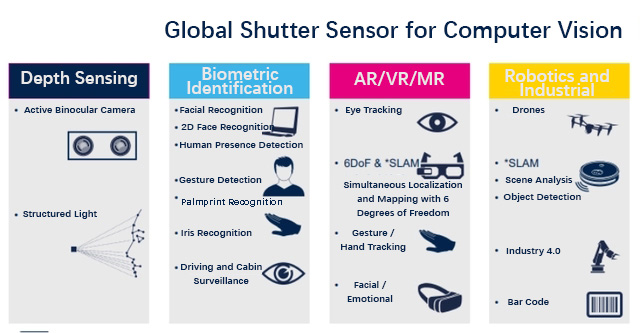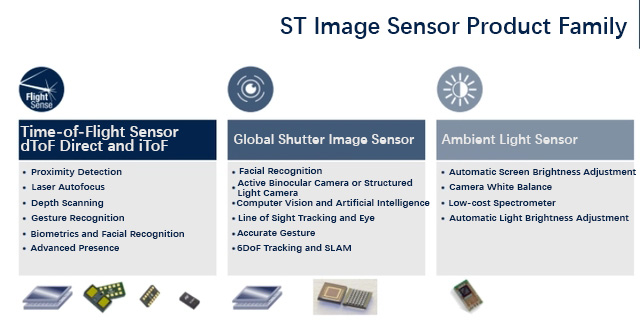The application of artificial intelligence has entered the“ "deep water area"”,and a large number of computer vision technologies have also“"gone to the front desk."”And the realization of computer vision cannot be separated from the support of image sensors, and in this regard global shutter sensors have become the preferred imaging technology with extremely competitive cost and accurate measurement.

Computer vision is headed for a global shutter
Computer vision, as a branch of artificial intelligence, enables computers and systems to extract meaningful information from digital images, videos and other visual input data, and take actions or make suggestions based on this information.
Lin Guozhi, technical marketing manager of ST Asia Pacific Imaging Division, introduced that from the application scenarios of computer vision, there are four main categories, The first is depth sensing, which is used in application scenarios such as face recognition and 3D scanning. The second is biometrics, this application collects information from various parts of the human body and uses it for identification, including face, palm print and iris. The third is AR/VR/MR, which heats up further under the concept of metaverse. The fourth is robotics and industrial control, such as drones and cleaning robots need to avoid collision during use, requiring object detection and scene analysis capabilities, including barcode recognition.
The implementation of the above applications will pass through a key carrier, which is the global shutter sensor.
The reason why the global shutter is“"in power"”,Lin Guozhi explained , as one of the two technologies of the sensor, the rolling shutter sensor is designed to capture stationary images and video shooting, so it has a very high resolution and color processing capability. But its disadvantage is that it is shooting images line by line, and the time of exposure is too long, if the shooting object is a fast moving object such as a car, the image may be distorted, and the power consumption is too high, it is not suitable for computer vision. The principle of the global shutter is completely different. It takes the whole image at one time and all pixels are exposed at the same time. Moreover, the imaging effect is accurate, the time of exposure is short, and the power consumption is low. In the future, computer vision will move towards the global shutter.
In response to this market demand,SThas launched two types of products: one is VD55G0,with400,000pixels;the other isVD56G3,with1.5 millionpixels.Lin Guozhi added that these two types of products have three major advantages,first, the sensor 940nm has the highest quantum efficiency, which will bring extremely high NIR sensitivity;second, the resolution of the square sensor is the best match for the lens;finally,the sensor shooting time of ST is very short, which reduces the system power consumption while ensuring accurate imaging.
It should be pointed out that the pixel points of the rolling shutter are usually below1.1microns,while the global shutter is usually above2.2microns.Therefore,Zhang Chengyi, senior manager of the technology market of ST Asia Pacific Imaging Division, analyzed that in the traditional consumer photography and imaging fields, rolling shutter sensors should still be very popular. Moreover, automotive ADAS or rearview mirrors will still be dominated by rolling shutter sensors, but global shutter sensors will be widely used in the fields of driver and passenger monitoring, automotive entertainment information systems, and automotive safety.
Full coverage of global shutter applications
Based on the advantages of global shutter sensor, it has found new uses in different fields such as consumption, industry and automobile.
But obviously, different industries have different needs for image sensors and need to divide and conquer. Zhang Chengyi pointed out that the application of smart home needs to be considered thoroughly, because users do not want to be monitored by cameras all the time, but they also need the comfort brought by sensors. In response to this, ST's global shutter sensor has developed a series of human-machine interaction functions, such as headcount, face recognition, and so on.
In the field of notebook and PC, Zhang Chengyi believes that the significance of applying global shutter technology lies in the ability to carry out facial recognition, gesture control, eye tracking, comfort monitoring and privacy protection. In addition, ST also provides ToF and ALS products, which can carry out presence detection, battery life, screen brightness automatic adjustment and privacy protection.
Needless to say, the demand for cameras in smart cars is developing rapidly. According to Yole, the market penetration of in-vehicle cameras will be about 10% by the end of 2021, and 50% by 2024.
In the field of in-car cameras,Euro NCAP the vehicle evaluation standard system,divides in-car monitoring systems into two categories,:one is the driver monitoring systemDMS,and the other is the cabin /occupancy monitoring systemCMS/OMS.The two-in-one system of cabin monitoring + driver monitoring combines CMS, OMS and DMS, and supports RGB and NIR at the same time with a single camera.
In response,STintroduced two generations of global shutter sensors for automobiles.
According to reports, the first generation includes four types of products:The first isVD5661A,it has a resolution of 160 million and mainly used for DMS. The second is VD5761A which has a resolution of 230 million , it belongs to Mono and can also be used for DMS. In addition, there are VD6763A with color RGB and VD1762A with RGB-NIR integration. Zhang Chengyi said that these products have three major advantages. One is high contrast, and being able to output images with extremely high contrast means being able to obtain more accurate information. The second is that the data management of RGB and NIR is very flexible. The third is high dynamics, so that clear images can be obtained in bright and dark environments.
The second generation VB56G4A has 1.5 million resolution and is mainly used for driver monitoring, VB56G4A has three major advantages. Firstly, high sensitivity, the high sensitivity of NIR means no need for powerful LED light source, because LED energy consumption will bring higher power consumption; Secondly, the small sensor area means that the camera module can also be made smaller and easier to install inside various mechanical devices; finally, the integrated intelligent auto-exposure algorithm eliminates the need for manual operation.
"In the future, ST will continue to shrink in pixel size, optimize power consumption, and continuously innovate and integrate at the level of algorithms and processes to further expand the market." Zhang Chengyi finally stressed.

It can be said that the ST global shutter sensor has its proprietary pixel technology, higher square resolution and a variety of embedded computer vision functions, which can fully meet the requirements of computer vision applications. Moreover, ST provides not only global shutter technology, but also optical technologies such as time of flight and ambient light sensors. Customers can integrate these different products into various scene applications according to their own needs to adapt to future application requirements.
(The above content comes from the network excerpt-Aiji Micro, invasion and deletion)
